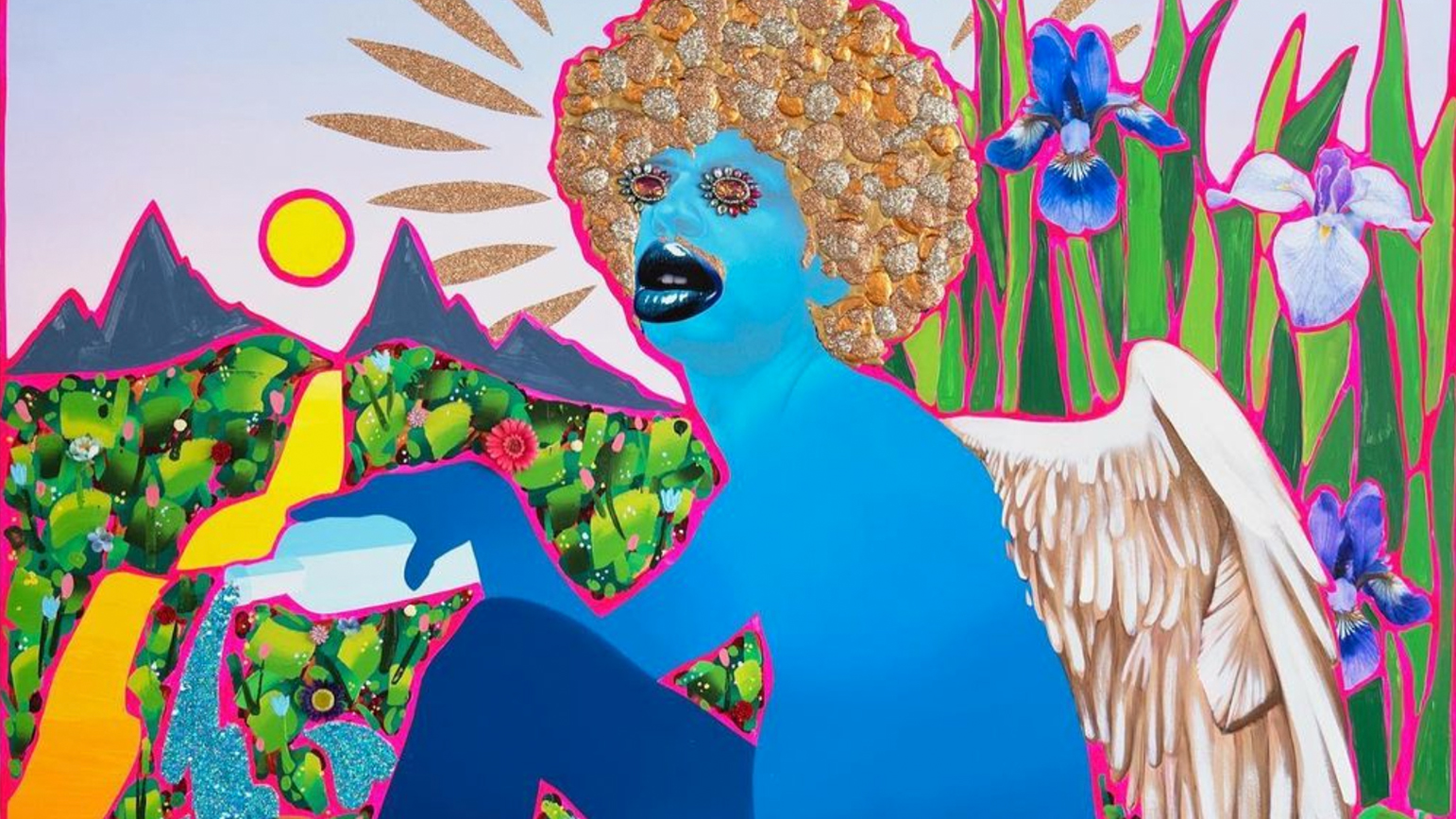
Professor Devan Shimoyama will present his second solo show at Kavi Gupta Gallery in Chicago from April 8 through June 11. The paintings and sculptures in the exhibition, titled “A Counterfeit Gift Wrapped in Fire,” examine cultural representations related to transformation.
The result of a long period of self-reflection for Shimoyama, the work materially alludes to an internal dialog he has been wrangling with concerning the difference between superficial and true change—a discrepancy noticeable at all levels, from the societal, to individual interactions in which we perform social niceties for each other rather than admit the truth about how we are doing.
“We have this desire to present outwardly as contained and keeping it together,” Shimoyama says. “We think it’s a gift to say, ‘I’m fine.’ There’s a mimicry of something really desired, but it’s fake. There’s a danger to that kind of thing.”
Many works in the exhibition reference tarot cards, which for Shimoyama relate to how mysticisms can help people adapt to difficult or tumultuous times.
The painting “Tempérance” portrays Shimoyama as a translucent, blue angel. Like the tarot card of the same name, the painting shows a figure pouring liquid from one container into another. Traditionally, it is assumed a cup of water is diluting a cup of wine—a reference to the virtue of restraint. The cup in Shimoyama’s painting is overflowing, accumulating into a lake at his feet, trading the poison of personal dilution for the virtue of natural abundance.
“Sustheno” portrays the downtrodden face of an exasperated, snake-haired being. The title references Stheno, the oldest sister of Euryale and Medusa, the mythological Gorgons. Stheno, whose name means “forceful one,” was the most ferocious Gorgon, taking the lives of more men than both of her sisters combined. Brutally rendered by Shimoyama, this figure’s sad, bejeweled eyes personify the melancholy of excellence and the burden of immortality.
“La Mort” shows a skeletal figure wielding a scythe and crouching over a decapitated head and severed hand in a flowery field. Behind the skeleton flows a river formed of the same bedazzled, blue water from Tempérance. The traditional Death tarot signifies transition or transformation rather than tragedy. Here, the severed head might speak to the body-mind disconnect that many of us feel these days.
“The hand in this painting is Rihanna’s,” Shimoyama says. “I think about the death and rebirth of her career. People wanted more, but she pivoted and didn’t deliver in that capacity. I’m going through similar shifts in my life that are substantial. This is a moment of rebirth in a lot of different ways.”
Shimoyama further explores the playful side of rebirth in a series of five drag-inspired self-portraits, in which he dons the hairstyles of Ronnie Spector, Lisa “Left Eye” Lopes, Aaliyah, Coi Leray, and Patti LaBelle—some of the beloved musicians who have influenced his own personal and professional evolution.
Metamorphosis is also at the heart of Shimoyama’s new series of paintings based on the transformation sequences that occur within comics genres, such as manga. Through multi-panel compositions, these paintings portray figures in the midst of undergoing external and internal transmutation. One painting in the series portrays Shimoyama during three different points of a transition into a butterfly-winged sylph. Another shows a double portrait of a crying figure, with one panel zoomed in acutely on the figure’s glittering tears.
These transformation narratives extend beyond the edges of the paintings into a series of vinyl wall prints that appear throughout the exhibition, referencing iconic, metamorphic moments in pop culture—such as Will Smith’s tearful eyes as he embraces his son in one of the final scenes of the movie “The Pursuit of Happyness,” and the inscrutable eyes of Usagi Tsukino as she pauses time in front of her awestruck and soon to be vanquished enemies to flamboyantly transform into her alter ego, Sailor Moon.
Accompanying the two-dimensional works in the exhibition is a hanging sculpture of knotted boots and shoes suspended from a wire. Reflecting on the meaning and value of memorialization, the piece continues a conversation Shimoyama began with his 2019 swingset sculpture “Untitled (For Tamir),” and his 2021 Smithsonian FUTURES installation “The Grove.”
“Part of this show is about paying attention to omens and thinking about how mythology is integrated into everyday life,” Shimoyama says. “When I think of the title, I think of how it feels to give something that’s fake, but mimics a more luxurious or expensive gift. It’s also about humor though, and the danger of failing to look beyond the faux finish of what we think we perceive.”




